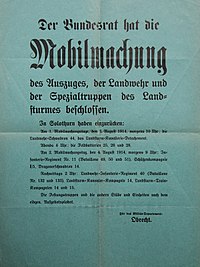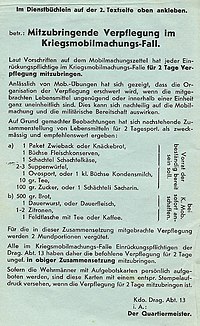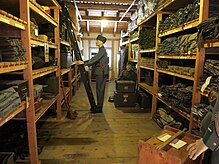Mobilization (Switzerland)

The mobilization of the Swiss Armed Forces into active service is ordered by the United Federal Assembly in the event of a threat from outside ( national defense ) or in the event of a threat to internal security (security service). In the event of war, individual troops (partial mobilization) or the entire army (general mobilization , general mobilization , white poster with a red diagonal bar) are called up for active service. Since the Swiss militia army - apart from the troops currently in training - does not maintain a standing army , those obliged to do military service have to keep both their personal equipment and personal weapons at home in order to enable faster mobilization.
prehistory
The history of mobilizations reflects the history of Switzerland. In the Old Confederation every fit man was obliged to serve. In order for the estates (cantons) to be able to mobilize the entire armed forces available within a very short period of time, the armed forces man had to keep his weapons and equipment at home and, when mobilized, move to the predetermined assembly point .
Since the middle of the 15th century ( Bernbiet ), the troops were alerted with warning fires from high watches. In the 17th and 18th centuries, Bern had a signal point network between the Rhine and Lake Geneva with 156 high watch, Thurgau 51, Freiburg 33, Zurich 23 and Lucerne 17. The very fast alarm system allowed the signal to be passed on to all 23 high watch in the canton of Zurich in 15 minutes.
The Diet laid down the supply measures and the degree of readiness for mobilization for the entire Swiss Confederation. The Defensionale determined the size of the troop contingents of the estates and the three-part contingent of troops with a total of around 40,000 infantrymen, 1,200 cavalrymen and 48 guns.
Mobilizations since 1792
Since 1792, when federal troops protected the border near Basel, there have been five general mobilizations (1856, 1870, 1914, 1939, 1940) and 130 partial mobilizations. Between the French invasion of 1798 and the revision of the Federal Constitution of 1874, there were 25 mobilizations, acts of war or troop marches: The Swiss federal state, founded in 1848, became particularly popular in 1849 (Büsingen trade), 1856 ( Neuchâtel trade ) and 1870/71 ( Franco-German War , internment the Bourbaki Army ) put to the military test.
The centralization of the army began with the state. During the occupation of the border in 1870/71, General Hans Herzog found serious deficiencies in mobilization, training and arming of the cantonal troops made available to the Confederation . In 1884 the first ordinance on the mobilization of the federal army was issued with the main aim of increasing speed. With the revision of the Federal Constitution of 1874 and the Federal Act on Military Organization, national defense became a federal task. In 1884, the Federal Council issued the first ordinance on the mobilization of the federal army, with the aim of accelerating the mobilization (cantonal armories for material and place of deployment of the troops, verbal, telegraphic and poster-based mobilization, preparations for food, accommodation, requisition horses and wagons Municipalities).
In 1907, the mobilization ordinance was simplified and made clearer: the mobilization was led by a field commander and the preparations of the cantons were monitored by the divisions general staff officers. The soldiers were able to travel to their destination using public transport and the service booklet as a ticket, where each unit could collect its material, weapons and ammunition. The handing over of the flag and the swearing-in had to be completed on the morning of the second day.
First World War
In 1914 the first regulation for war mobilization (K Mob) was issued. The mobilization was carried out by the Federal Military Department directly to the municipalities and train stations. Only the federal mobilization poster was valid. New armories were built and the railway network expanded. On July 31, 1914, the Federal Council decided that the army should be on standby and, on August 3, the general mobilization of the exodus and the Landwehr (including those living abroad). For the first time, the Landsturm was given the task of covering mobilization and troop deployment. The mobilization (including the provision of horses and vehicle acquisition) was due to the good preparations by the General Staff, military administrative authorities of the Confederation and the cantons, and field and troop commanders everywhere without friction and according to plan.
The experiences from the First World War and the military-technical development led to adjustments of the mobilization organization. The 1927 regulations on field service emphasized the importance of rapid mobilization. The new threat posed by the air force led to the decentralized storage of material and ammunition outside of armories and depots. In 1932 a decentralized mobilization system was introduced: staffs and soldiers were to be deployed at a larger number of assembly points at different times. As the first squadron, mobilization officials, alarm detachments and border guards were called up before the army was on standby. The second season was general mobilization, which had to take place within five days. In 1937, mobilization places for the Landwehr and Landsturm were introduced and, together with armories, motor vehicle parks and the railway service, were subordinated to the federal government. The K-Mob regulations now applied to the border protection troops (provision of border works, reinforcement of the fortress garrison, distribution of corps material, etc.)
Second World War
On August 28, 1939, the Federal Council issued posters ordering the mobilization of 80,000 border guards and, on September 1, general mobilization for the next day. A mobilization slip was stuck on the first page of each soldier's service book, stating the corp assembly point, mobilization day and hour as well as the necessary mobilization information. The material collection detachments moved in immediately, and on the following day 430,000 combat troops, 200,000 conscripts and 10,000 women from the newly established women's aid service (FHD). The general mobilization went smoothly within three days. The second general mobilization was triggered on May 10, 1940 and was also organized with almost 700,000 soldiers or twenty percent of the population.
During the active service there were 80 partial mobilizations in order to relieve troops and to practice maneuvers or troop deployments. During the war, however, never more than 80,000 men were constantly under arms and thus withdrawn from the economy and family. From 1941 onwards, "silent mobilizations" were made by sending marching orders to certain troops. Since German plans of attack provided for the rapid occupation of the Reduite entrances by airborne troops, the general had these permanently secured by strong formations, which were called up using marching order cards. Normally the Federal Council approved the mobilizations demanded by General Guisan. One of the exceptions was a contingent on the Allied landings in Normandy in June 1944.
Cold War
With the Army 61 (nuclear war, air warfare, new weaponry and war forms) and the shorter warning times was responding to the new threats. General new mobilization regulations were issued, which, together with the new civil protection concept, were for the first time embedded in an overall defense concept .
As a means from the first hour, a management staff was formed, which, at the first signs of threat, took over the operational preparations for defense until mobilization was triggered. Aircraft and anti-aircraft troops, standby troops ( WWII troops staggered over the year), alarm formations (airport regiment 4 with operational readiness within 2-3 hours, etc.) and mobilization organs were available to the command staff . The precautionary measures included the decentralization of ammunition, (armored) vehicles, aircraft, armories, etc. Staffs, commanders and mobilization organs were prepared and practiced for upcoming missions with a system of graduated levels of readiness, without the bulk of the troops depriving the economy and the public had to become.
The mobilization was the first decisive operation of the Army 61, because, given the threat of the Cold War, immediate readiness for action was crucial, even for a militia army. Since in the militia system the soldiers are needed to the end in the economy, a finely tuned mobilization organization had to be developed that compensated for the disadvantages of a non-standing militia army through organizational measures. Its main features were laid down in 1884, and have been continuously developed and refined since then. In Army 61, all troops, coming from civil life, could be ready to fight within 24 to 48 hours.
The mobilization system became one of the organizational focal points of the army 61. With a powerful intelligence service (early indicators) including defense (espionage and decomposition) and by means of precautionary measures, all forces should be bundled in good time so that in the event of mobilization all resources were available to support the to be able to start up the necessary operational readiness on time. Because the planners reckoned with covert, asymmetrical warfare and strategic raids that could disrupt mobilization, guard duty with a loaded weapon was introduced - among other measures - in the 1970s for the refresher courses.
A mobilization department was established to strengthen the mobilization organization. The 53 mobilization places became more important with Army 61. The staff of the mobilization organization were recruited from former or active officers who had civilian responsibilities in the communities. The local mobilization organization was anchored in the population. The mobilization was accelerated, a subsequent immediate training of the troops was prepared and a rapid shift to the prepared basic combat disposition was practiced. In the annual repetition courses, the militia troops were able to regain full readiness for war within three weeks. The recruitment for the refresher course often turned into a war mobilization exercise (K Mob exercises), whereby the detachment of the material had to be at the point of entry by 8 a.m.
Based on the report of the Federal Council on the conception of the national military defense of June 6, 1966, the Swiss army command began for the first time to draw up basic deployment plans for the army in advance using rolling operational planning. Starting from the largely fixed mobilization device, the basic device "Zeus" was developed in 1992 as a combat device, which could quickly be drawn from the mobilization device. The advantage of «Zeus» was that the militia troops knew the country, the people and the combat infrastructure and regularly practiced defensive combat in these rooms dynamically in the refresher courses.
The Army 95 abolished the partial mobilization system, 17 mobilization places and the basic disposition in favor of remaining in the mobilization disposition. Now, in an emergency, the units currently on duty, then the alarm formations and then, depending on the assessment of the situation, further troops had to deploy according to the deployment. For a general mobilization, years of warning times («growth principle») were expected.
today
After the end of the Cold War, the Army XXI was reduced to 220,000 men in 2003 . The rapid mobilization system was abolished and replaced by the tiered readiness system that no longer required mobilization places. The regional armories were closed and centralized in five logistics centers. For immediate deployment for subsidiary missions in the event of a disaster or to support civil authorities, service personnel, professional and temporary military personnel and troops in the training service should be called in. After a medium preparation time (72 hours), further units should be deployed to secure the area (reinforcement of the border guards, property protection). A longer preparation period of a few months was planned for the deployment of the reserve troops of 80,000 men.
The planned further development of the army (WEA) wants to increase the operational readiness of the army again. The new standby system requires the reintroduction of a mobilization organization.
literature
- Louis Geiger, Franz Felix Betschon : Memories of the Army 61 . Huber, Frauenfeld 2014, ISBN 978-3-7193-1513-9 .
- Swiss War History 1915. Society Archives of the Swiss Association of NCOs (GA SUOV)
- Arnold Linder, C. Aversano: The Mobilization of the Swiss Army in the Last 100 Years . Swiss Mobilization Department, Swiss Staff of the Group for General Staff Services 1985.
- Emile Buxce: L'armée suisse mobilise. Petite histoire de mise sur pied, XIVe-XXe siècle . Les Cahiers de la Renaissance vaudoise, Ligue vaudoise 2003, ISBN 2-88017-141-5
- GJ Peter: Hochwachten . In: On the history of the Zurich defense system in the 17th century . 1907
- NZZ Online Archive 1948: E. Stauber: Hochwachten
- Museum in the armory : mobilization. The mobilizations of the Swiss Army since 1792 . Catalog for the exhibition in the Museum im Zeughaus, Schaffhausen from May 10, 2014 to the end of 2015.
Web links
- Hervé de Weck: Mobilization. In: Historical Lexicon of Switzerland .
- Zürcher Oberland from August 6, 2014: Mobilization 1914 in Uster with tears
- NZZ of September 2, 2014: Mobilization of the army from 1939
- Tages-Anzeiger from August 4, 2014: Mobilization in the museum
- Swiss television from September 2, 2014: Second World War: 75 years of mobilization in Switzerland
- Traveling exhibition: Switzerland and the Great War 1914–18
Individual evidence
- ^ Swiss Federal Constitution, Articles 2, 58, 59, 168, 173, 185
- ^ Wyrsch-Ineichen, Paul: The Schwyzer troops in the Büsinger trade 1849 from 1985 in communications of the historical association of the canton Schwyz
- ^ Hans Senn: Active service. In: Historical Lexicon of Switzerland .
- ↑ Bernhard von Arx : Confrontation - The truth about the Bourbaki legend . Verlag NZZ, Zurich 2010, ISBN 3-03823-618-7
- ↑ a b Museum in the Armory: "Mobilization. The Swiss Army Mobilization since 1792". Catalog for the exhibition in the Museum im Zeughaus, Schaffhausen from May 10, 2014 to the end of 2015
- ^ Report of the general on active service 1914-18 to the Federal Assembly and of the chief of staff on mobilization to the general
- ^ Gotthard Frick: Hitler's War and the Self-Assertion of Switzerland 1933–1945 . Self-published, Bottmingen 2011, ISBN 978-3-033-02948-4 .
- ^ Franz Betschon: Mobilization and readiness for action . In: Memories of the Army 61 , Verlag Huber, Frauenfeld 2014 ISBN 978-3-7193-1513-9
- ↑ Louis Geiger, Franz Betschon: Memories of the Army 61 . Verlag Huber, Frauenfeld 2014, ISBN 978-3-7193-1513-9
- ↑ Jungfrau newspaper of April 26, 2004: Armory houses are gradually disappearing from the scene
- ↑ Peter Braun, Daniel Fuhrer: The planned further development of the Swiss Army (WEA) in its historical and international context . In: Military Power Review of the Swiss Army, No. 2/2013, publisher: Chief of the Army
- ↑ Marc Tribelhorn, NZZ of May 16, 2017: Swiss Army. Mobilization at the push of a button














